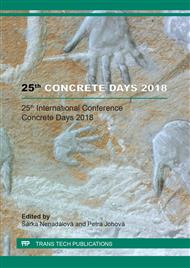p.63
p.69
p.79
p.85
p.91
p.96
p.102
p.108
p.114
Influence of the Amount of Ammonium Salts in Fly Ash on Concrete with Ternary Binders
Abstract:
The requirements for reducing nitrogen oxide emissions have led power and heating plants to installing reduction technologies such as the selective non-catalytic reduction (SNCR). The paper deals with the influence of the amount of ammonium salts in fly ash from power plants where SNCR method is used on the properties of mortars with ternary binders. Portland cement is the main component of this ternary binder system. As other components, fly ash and lime or finely ground recycled concrete dust were used. The synergic effect of all three components helps us to get a higher initial strength. This is caused by the presence of calcium carbonate and aluminate ions in the system. The chemical and physical-mechanical properties of fly ash are presented; especially, the amount of ammonium salts in accordance with ČSN ISO 7150-1 and the specific surface area. On mortars, the activity index of compressive strength and workability was examined.
Info:
Periodical:
Pages:
91-95
Citation:
Online since:
June 2019
Authors:
Keywords:
Price:
Сopyright:
© 2019 Trans Tech Publications Ltd. All Rights Reserved
Share:
Citation:


